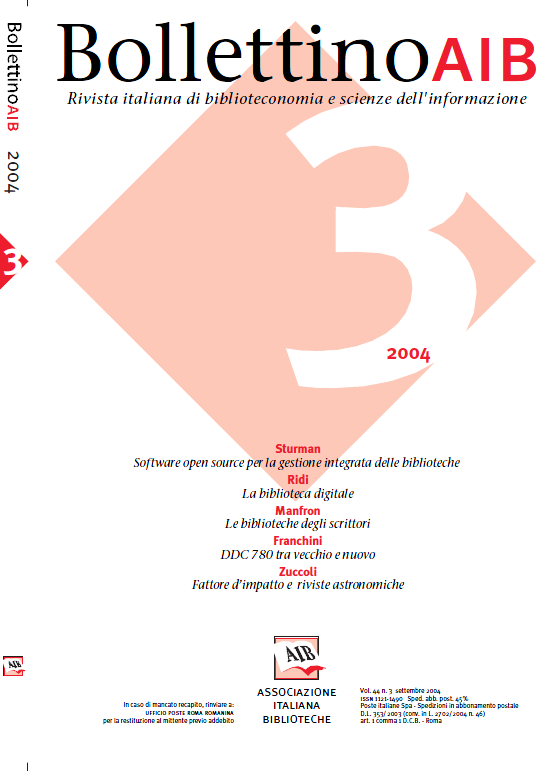Digital library: definitions, ingredients and problems
Main Article Content
Abstract
The concept of digital library must not be confused with those, correlated but different, of virtual library and hybrid library. The digital library is rather the borderline case of an hybrid library in which analogic documents and non-electronic services are set to zero. Among the documents of the digital library a distinction must be done between the primary digital collection, made up of documents that were originally published in electronic format, and the secondary digital collection, made up of subsequent digitalizations of original analogic documents.
The ingredients of every digital library are on the one hand its documentary collections and on the other the services supplied to its users. Among the main typologies of documents are the e-journals, the e-books, the open archives, the databases and the opacs. For every typology the main features and the fundamental problems under discussion nowadays are described. In particular, with regard to opacs, the article deals with the problem of how to insert in them the descriptions of the RER (remote electronic resources) and of the LER (local electronic resources) owned or selected by the library. Moreover the main services of the digital library are presented: virtual reference service, print on demand, document delivery, acquisitions, loan, sign system, marketing, electronic reserve, data mining, discovery of plagiarism, selected dissemination of informations and documents, measurement of collection use, and communication among users.
Among the open issues related to the digital libraries, some are singled out as particularly crucial and therefore examined closely: access, conservation and preservation, standardization, interoperability, cooperation, evaluation, interfaces and information retrieval copyright, privacy, and metadata, both descriptive and semantic, and administrative and managerial.
The quantitative and qualitative explosion of digital information resources makes it indispensable to strengthen the tools, conceptual and technological, necessary to amalgamate and use at best the many ingredients of the digital library. Among these tools the “semantic web” and the softwares for the “reference liking” are noteworthy, but an even greater integration could arise from a more rational division of tasks among open archives, e-journals, bibliographic databases and digital libraries: this is the author's proposal for the future.
The paper closes with a rich bibliography, partially annotated: 300 items in Italian and English, particularly from 1999 to 2004, half of which available free on the web.
The ingredients of every digital library are on the one hand its documentary collections and on the other the services supplied to its users. Among the main typologies of documents are the e-journals, the e-books, the open archives, the databases and the opacs. For every typology the main features and the fundamental problems under discussion nowadays are described. In particular, with regard to opacs, the article deals with the problem of how to insert in them the descriptions of the RER (remote electronic resources) and of the LER (local electronic resources) owned or selected by the library. Moreover the main services of the digital library are presented: virtual reference service, print on demand, document delivery, acquisitions, loan, sign system, marketing, electronic reserve, data mining, discovery of plagiarism, selected dissemination of informations and documents, measurement of collection use, and communication among users.
Among the open issues related to the digital libraries, some are singled out as particularly crucial and therefore examined closely: access, conservation and preservation, standardization, interoperability, cooperation, evaluation, interfaces and information retrieval copyright, privacy, and metadata, both descriptive and semantic, and administrative and managerial.
The quantitative and qualitative explosion of digital information resources makes it indispensable to strengthen the tools, conceptual and technological, necessary to amalgamate and use at best the many ingredients of the digital library. Among these tools the “semantic web” and the softwares for the “reference liking” are noteworthy, but an even greater integration could arise from a more rational division of tasks among open archives, e-journals, bibliographic databases and digital libraries: this is the author's proposal for the future.
The paper closes with a rich bibliography, partially annotated: 300 items in Italian and English, particularly from 1999 to 2004, half of which available free on the web.
Article Details
Section
Articles
